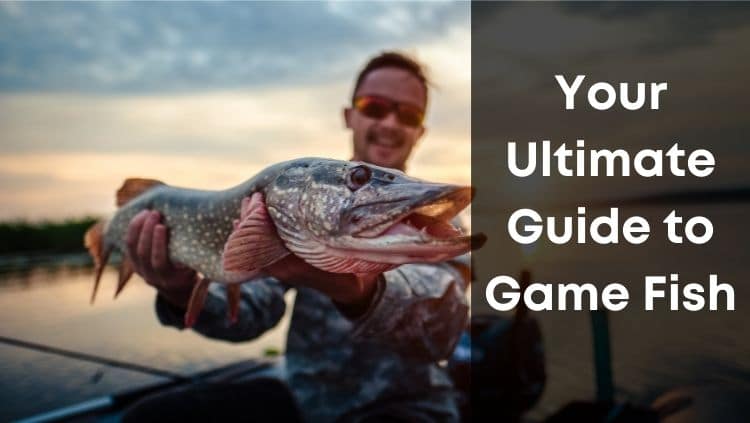Game fishing is an increasingly popular sport in the United States. Whether you’re an experienced angler or just getting started in the sport, you likely have questions about what game fish are the most popular, what non-game fish are worth your time, and what exactly game fishing is all about.
This article will explain some of the technical jargon that goes along with game fishing. We’ll also talk about some of the most popular game fishing species and some under-rated non-game fish that are worth your time.
What is Game Fishing
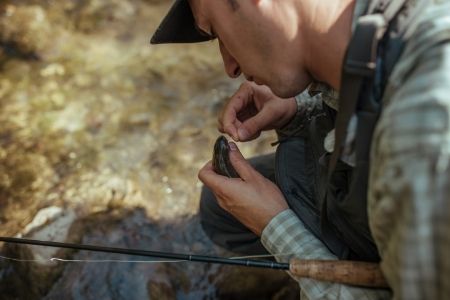
To explain it as simply as possible, game fishing is a sport in which recreational fishers target specific fish species for a particular reason. Typically, a fish species is targeted either because it puts up an excellent fight like tarpon or makes excellent table fare like grouper.
Game fish species are also targeted in competitive events like bass or marlin tournaments. The species targeted for tournaments put up tough fights or take particular know-how to catch them, making it a contest of skill.
What Makes a Species a Game Fish?
For recreational anglers, game fish are desirable species that put up a good fight or are targeted because they are good to eat. But game fish are generally categorized as game fish because they have commercial value.
Many states will classify a species as game fish because it makes it illegal to harvest a fish commercially. For example, spotted sea trout are an angler’s game fish in Florida but aren’t classified as a game fish by the state to allow commercial harvest of the species. While a state may not consider a species a game fish to allow commercial fishing, the species can still be a popular target for sport anglers.
So whether a species is considered a game fish or not depends on whether it is recreational or commercially targeted, and each state decides the regulations for a species are. Typically sport fish are listed out by the state, and those are considered “game fish” for that region.
Game Fishing for You
In the end, game fishing is just targeting any species you want to catch. While plenty of species aren’t considered game fish, if you’re trying to catch a fish because you have fun doing it, you’re game fishing.
Top 5 Game Fish Species
When you think of the top 5 game fish, it varies quite a bit between freshwater or saltwater and where in the world you’re fishing. For example, snappers might be one of the most popular in Florida, but the number of anglers targeting bluefish is much higher since more of the country has them available. Here we’ll go over five of the most targeted game fish and throw in some honorable mentions that are more sought after in localized areas.
A survey was conducted by the US Fish and Wildlife Services, ranking game fish by the number of days anglers fished for particular species. The most popular species by far was bass, followed by crappie. Freshwater fish were more popular than saltwater fish by a wide margin, with the top three saltwater fish being flounder, seatrout, and striped bass.
Bass
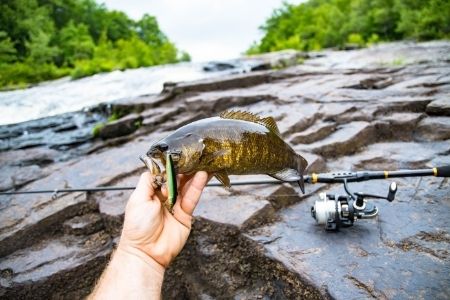
The number one game fish in the United States has to be bass, both largemouth and smallmouth varieties. With anglers spending more than 160 million days a year combined fishing for them, bass blows every other species out of the water.
Bass is an excellent game fish due to its selective nature, ability to put up an intense fight, and widespread availability. They’re popular because the bass is everywhere and can be found in nearly every water source.
Anglers don’t need a boat or any special knowledge to get into bass fishing, either. Bass are attracted to artificial lures, worms, and other small natural baits, making them an excellent target for any age or skill level anglers.
Bass are also meaty fish and are pretty solid table fare. So while many bass anglers will catch and release their catches, bass can make excellent eating. However, it is recommended to release fish that are in the spawning size range to help preserve the fishery for future generations.
Crappie
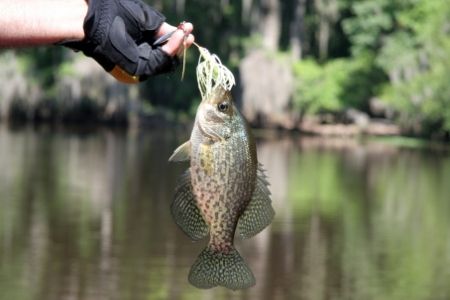
Anglers’ second most popular freshwater fish at nearly 100 million fishing days is crappie. Crappie is popular because of how tasty they are and how easy to catch.
Crappies are fish you can cook in a lot of ways. They taste great grilled, fried, or boiled and make excellent soups and stews.
Crappie is an excellent fishery because of how quickly they reproduce. Crappies spawn at early ages, quickly replenishing populations. More than this, since they’re always breeding and growing in population, they’re always looking for food, making them easy prey for any angler.
Crappie tends to hang around the banks of rivers and lakes, making them accessible to anglers of all ages and physical abilities. They don’t put up the fight of bass, but they’re still fun to catch, and with the multitude of crappie fishing methods available, it’s a great species to target for teaching kids or having a relaxing fishing day. In addition, the fishing gear needed for crappie isn’t heavy-duty or expensive, making the cost of entry for crappie fishing very low as well.
Flounder
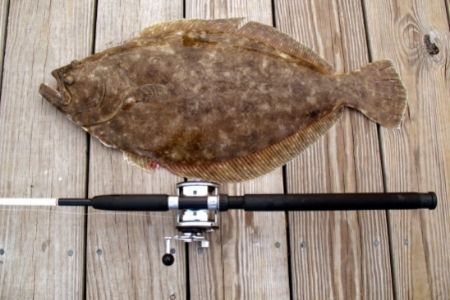
Saltwater fish may be dwarfed by freshwater, with flounder being the most popular saltwater fish at just under 20 million days fished by anglers. Flounders are found along both coasts of the United States and are targeted because they make excellent table fare and are so common.
Flounders are flatfish, meaning they have both eyes on one side of their body and lay flat on the seabed. As a result, they’re an excellent target for bottom fishing and bouncing jigs across the bottom in shallower waters.
Flounder can be taken on both rod and line and speared with flounder gigs. In addition, they are targeted by spearfishermen and by drifting through shallow waters with spotlights at night to spear them off of the bottom. Since you can take them in more ways than rod and line, they’re a great source of sport for anglers looking for tasty fish for dinner.
While the biggest flounders tend to hang around reefs and structures offshore, most flounders are found in shallow coastal waters. Therefore, you can target them from the beach and piers without the need for a boat, making them more accessible than offshore game fish.
Sea Trout
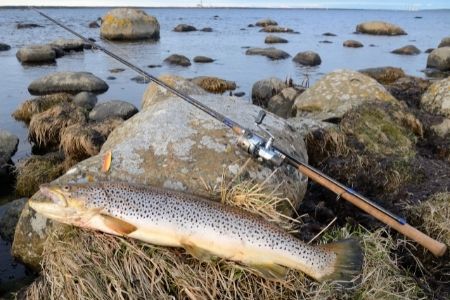
Sea trout of different species range across the entire coastline of the United States. Spotted seatrout, in particular, live along the entire Gulf of Mexico and East Coast from Florida to Maryland.
The coastal species hits baits and fights hard, making them an excellent target from shorelines and grass flats. In addition, they’re aggressive fish that will follow and strike lures consistently, making them fairly easy fish to target.
Trout are another fish that taste great. They feed primarily on shrimp, making their meat taste clean and light.
You can target trout with live baits, dead baits, lures, and flies. Fly fishing and wading grass flats are fun ways to target trout and get a great fight out of the fish. With trout, the larger the bait, the larger the fish that will strike, meaning you can scale up your technique to try for trophy fish as well.
Striped Bass
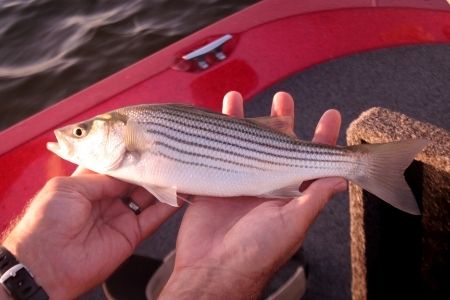
Striped bass is an incredibly popular fish in commercial and recreational fisheries due to its excellent taste, size, and strong fights. The best-striped bass fishing is found around the Chesapeake Bay area, but they are native to the Atlantic coastline from Mexico to Louisiana. Recently, striped bass has been found on the West Coast to extend their natural habitats.
Legal size limits for striped bass are generally close to thirty inches, getting much larger. They are also renowned for their fight once hooked. Striped bass will take artificial lures and freelined baits and have voracious appetites. Once you find them, they’re generally easy to get a bite out of.
Striped bass has very short commercial seasons to help manage the fishery, but their mild and firm flesh is fantastic eating. Broiled or roasted, striped bass is one of the best fish to eat.
Striped bass is the third most popular saltwater species in the United States at just under 20 million days fished by anglers each year. The world record striped bass weighed over 81 pounds, making them the largest species in this top five-game fish list.
Honorable Mentions
Some fish are sought after sport fish but aren’t fished for as much as others for various reasons. For example, some fish like kokanee salmon are very popular but aren’t widespread. Others like mahi-mahi and marlin aren’t easily accessible because large offshore species require more expensive boats or much more intensive gear to catch them. Other excellent game fish that aren’t fished as popularly as these five include:
Top 5 Non-Game Fish Species
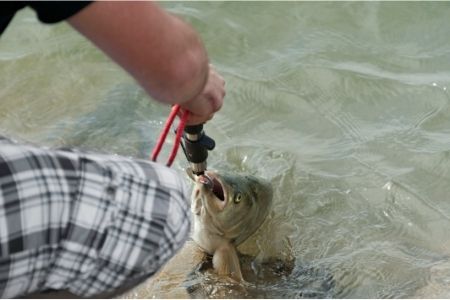
Non-game fish are typically smaller than sport fish and are used as bait for sport fishing. Non-game fish are essential to ecosystems as they are usual prey for game fish or bottom feeders that help keep waterways clean.
As discussed earlier in the article, some states don’t classify sport fish as game fish to allow commercial harvesting. However, in this article, we are still considering those fish as game fish, as in many cases, they are still the most popular sport fish species. You can find lists of non-game species on your state’s Fish and Wildlife website.
This section will highlight a few popularly targeted species but aren’t game fish. We also have a couple of fish considered garbage fish or bycatch but can still be great fish to catch with the right mindset.
Whiting
Whiting is a popular target for surf anglers. Large whiting is anything over twelve inches, and they are both great-tasting and make excellent baits for larger fish and sharks you might be targeting in the surf.
While small, whiting is feisty, hitting baits harder than their size would suggest. On light tackle, whiting is a fun little fish to fight, but large surf fishing setups usually overmatch them.
Whiting can be a fun fish to target since they live right on the beach’s edge in surf zones. On calm days you can sight cast flies and small jigs to them to get a hookup.
Whiting isn’t considered a game fish due to its size and can be commercially fished. They’re most commonly found in Florida, especially on the Atlantic Coast,
Carp
Primarily considered a nuisance in many waterways like the Mississippi River, carp is a large herbivorous fish that puts up a good fight. You can catch them on hook and line using dough balls, corn, or worms.
Carp are pretty good to eat but are an invasive species in most United States. The fish grows quickly and has gained a reputation as a popular sport fish for various fishing methods and intense fights.
You can find carp in lakes and streams across the United States, and as a non-native species, they aren’t classified as game fish. Bow fishing is common for carp, and there are generally large or no limits on fish since they are invasive and breed quickly. They tend to like shallower water, so fishing from shore is an excellent way to access the species.
Some areas of the Mississippi River are so choked with carp that driving a boat through the area causes them to jump out of the water in droves. You can find Youtube videos of people boating through the area, netting carp out of the air, baseball batting them, or even having the fish jump right into the boat.
Shad
Shad is a small schooling fish usually found in large rivers. They feed on plankton and minnows and can be seen jumping out of the water.
Shad make excellent baits for both bass and catfish. In addition, the small fish are natural prey for many game fish in lakes and rivers, making them a perfect choice for dead or live bait when targeting those species.
Using ultralight gear makes a fun trip out of the small shad. They usually weigh under a pound and will strike nearly any lure small enough for them to bite. 1/64 ounce jigs work great for small shad, and you can spend the day reeling in the tiny fish for fun with kids or to use as bait for larger fish later on.
Hardhead Catfish
Hardhead catfish can be a plague for some saltwater fishermen. They are incredibly plentiful in the Gulf of Mexico and along the Atlantic Coast and will take any natural bait. Surf fishers who use natural baits and fish them on the bottom will usually catch many of these catfish when targeting other species like redfish, pompano, and whiting.
Generally, hardheads are regarded as poor table fare. They are challenging to clean and dangerous to unhook due to their poisonous spines. Widely considered trash fish and a nuisance for anglers, you’re probably wondering why they make this list.
Hardhead catfish, and their cousins, the gafftopsail catfish, don’t put up much of a fight, don’t grow large, and aren’t good to eat. But they are everywhere. This fish is perfect for anglers who don’t care what they catch as long as something is biting.
You will still usually get a few hardhead catfish to take your baits when nothing is biting. While not a sought-after species, they are always around and always hungry. While you shouldn’t let kids handle them because of their spines, hardheads can make a great fishing trip for kids who are excited no matter what they catch.
Stingrays
You’ll rarely target a stingray unless you’re a bow fisherman who enjoys eating them. But stingrays of all species put up a great fight on hook and line and make an excellent fish for later stories.
Large Atlantic stingrays come closer to shore when the weather cools off. They’ve been caught in the surf over five feet wide and a couple of hundred pounds. Even heavy surf gear gets a workout bringing in a fish that large, and they’ll commonly run you a few hundred yards down the beach.
Stingrays are largely bycatch, taking cut squid or shrimp meant for other species. But, on the rare occasion you hook into one, you’ll leave the meeting with an unforgettable fight.
You can cut off your line if you aren’t comfortable landing the stingray, as they can still survive and feed afterward, but if you want your gear back, be sure to avoid the stinger on the base of their tail. Keep in mind that their mouth is on the bottom, and flipping over a massive stingray is a task all by itself.
Recreational Anglers and Game Fishing
Sportfishing is a passion many anglers hold dear to their hearts. Some fishermen dedicate all of their fishing time to certain species like bass because of how much enjoyment they get from it. Other anglers are happy as long as they’re catching something.
Whether you’re a seasoned pro or just getting started, there are plenty of accessible fishing styles and species out there for you. Check your local Fish and Wildlife Services website for information on species near you and all of your local legalities when it comes to fishing in your area.

